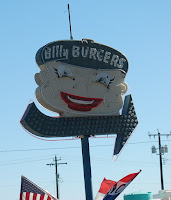The Yellowstone Trail wanted to be considered at the same level as the Lincoln Highway. In 1916 the Yellowstone Trail Association issued a challenge to the Lincoln Highway, challenging that Association to a cross-country race with each Association using its own highway. For whatever reason the Lincoln Highway Association did not respond to the challenge. I suspect that they felt that as the preeminent Highway Association they had little to gain and much to lose in any such race.
Despite the fact that the Lincoln Highway association begged off on the race, the Yellowstone Trail Association went forward anyway. They raced from Plymouth Rock to Puget Sound. The Yellowstone Trail Association's efforts took five days one hour and 12 minutes. This established a new record for transcontinental travel. In that effort the Yellowstone Trail's drivers took the route due west from Spokane across Washington. This eliminated more than 150 miles from the trip. Ultimately that route would become the Yellowstone Trail in its final incarnation. This is the route that we are taking today. We will return on the pre-1916 route going down through Sunnyside and over to the Tri-Cities before returning home.
Yesterday morning we began our daily drive from our campground in Coeur d' Alene, Idaho.
As you can see, we were the smallest "rig" in the campground. Our destination was only about 45 miles away, Riverside State Park in Spokane. In law school, Linda and I would often go camping at Riverside State Park in order to give us a break from the trials of law school and also to go shopping as Moscow, Idaho had very little in the way of shopping in the mid-1970s. We have fond memories of Riverside and our camping expeditions there. I guess we were hoping to relive these experiences, but this trip disappointed us in that regard.
As you can see, we were the smallest "rig" in the campground. Our destination was only about 45 miles away, Riverside State Park in Spokane. In law school, Linda and I would often go camping at Riverside State Park in order to give us a break from the trials of law school and also to go shopping as Moscow, Idaho had very little in the way of shopping in the mid-1970s. We have fond memories of Riverside and our camping expeditions there. I guess we were hoping to relive these experiences, but this trip disappointed us in that regard.
Riverside is becoming overused. In addition, the Covid 19 restrictions meant that the water for campers was turned off. (Why, I really don't know?) Camping everywhere has been crowded. But with many Washington state schools closed, this meant that there were a lot of kids in the campground. This is not so bad in and of itself, but the five kids in the campsite next to us "were free range" children. We were disheartened that they didn't respect outdoor rules of courtesy. Their parents didn't keep them quiet and even seem to encourage their yelling and screaming.
The Davenport Hotel in Spokane is quite grand. Louis Davenport was the proprietor and overseer of the building of it. It has the distinction of being the first hotel in the United States with air conditioning.
After getting a reasonably good night sleep, we broke camp when the children in the next campsite awakened us. After a quick coffee, we got on "The Sunset Highway" in Spokane, the name given to Highway 2 in Washington, and headed west. It travels on an east-west route across the state. By and large, it is a good road, but there are not many towns along the route.
The scenery is interesting in his own way. We first came across "The Washington Scab Lands", which is a remnant of the flood when the ice dam which formed Lake Missoula, released the water which resulted in a flood across Northern Idaho and into Eastern Washington. In places the flood deposited tons of rich soil which can be seen in the rolling Hills of the Palouse.
In other places the flood scoured the land and left it devoid of vegetation and topsoil. This is the case in the scab lands. The soil reminds me of the Loess soil of Western Iowa which we observed during the 2017 Lincoln Hwy. conference. The Palouse soil is just as rich as the soil of Western Iowa, but it was formed in a vastly different way.
Just west of Spokane we passed through the town of Davenport, Washington. The town is named for its founder, John C Davenport, not the Davenport who was founder of the Davenport Hotel. (Although the two may have been related.) The Courthouse, built in 1897, was an important center for the residents until 1995. It was burned to the ground by a local teen. It was painstakingly restored, including the original iron fence that had been removed to aid in the war effort of WWII.
From Davenport we continued due West and soon passed through the little community of Wilbur, Washington. There was a hamburger stand here which serves "Billy Burgers" and also a tribute to Charlotte's Web. There is a statue of Wilbur the pig and next to Wilbur is a spider's web featuring Charlotte. West of Wilbur we passed through Coulee City, home of the Grand Coulee Dam.
We continued through central Washington until we came to the town of Wenatchee. Wenatchee is on the west side of the river across from East Wenatchee.













